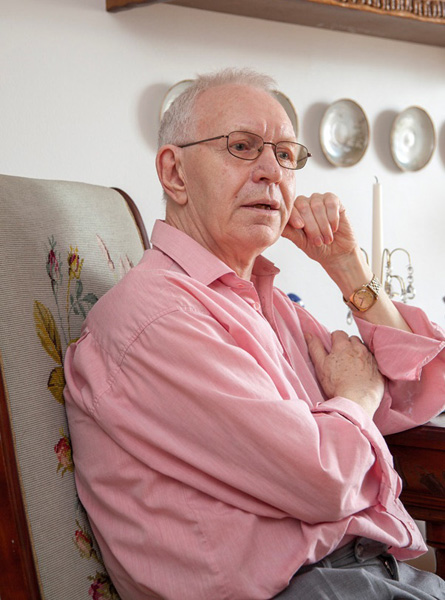About Herder
Chasubles and altar clothsHerder Andersson was born in 1933 and brought up from the age of six in the seaside town of Lysekil on the west coast of Sweden. As a young child he attended church every Sunday and early on he developed a passion for every type of needlecraft. As a youth he went to Stockholm to seek an education and took advantage of every opportunity available to a working class boy, although money was often tight. There he met his future partner, the Icelandic veterinary surgeon Gudbrandur Hlidar, and in 1958 when Herder turned 25 they moved together to Iceland. While in Stockholm, Herder studied classical ballet for seven years and finished his teacher training at the famous studio run by Madame Lilian Karina, one of the top ballet teachers in Sweden in the mid-twentieth century. He also obtained a degree in fashion design and fashion drawing from Stockholm University. His studies would be of service to him when it came to designing and creating chasubles.
A book ‘Messuhöklar og altarisklæði’ was published on the occasion of Herder’s ninetieth birthday on 23 November 2023 and contains photographs of some of the chasubles and altar cloths designed and created by Herder Andersson between 2006 and 2014. During this period Herder produced 27 chasubles in total, 13 of which he gifted to churches in Iceland and the other 14 to churches in Sweden. The following pages contain photographs of the 13 chasubles gifted to churches in Iceland.

Herder says this about his art:
“Looking back, I sometimes wonder if I was completely conscious when I was sewing — despite being wide awake. The needle simply flowed along its own smooth, steady path. Sewing was my meditation.
“I would always sketch what I saw before me or what I imagined, I gave myself plenty of time to search for ideas with my pencil and sketchbook in my hand, and was careful not to copy earlier examples of religious clothing. Gradually my ideas would form clearly in my head, although they often underwent surprising changes when I started to sew. To some extent I taught myself the various stitches through studying old pieces of embroidery; I don’t recall ever opening a book to familiarize myself with a stitch. My knowledge of fabrics and textures also came in handy when I began to make chasubles. I mostly chose satin or velvet, occasionally silk, and here again my knowledge of fashion design proved useful — which natural properties each fabric possessed that would bring the garment alive to the eyes of churchgoers.
“I mainly looked to the ecclesiastical year for colours, as each has its special symbolism. Occasionally I allowed myself a degree of licence, for example I once made a chasuble with a rose pattern, to reflect the spirit of summer and the growing season.
I spent a long time choosing embroidery threads, and ended up with several thicknesses depending on the size of the stitches. After I’d finished embroidering I then had to line the chasubles and insert zip fasteners into the left shoulders, all of which of course I did by hand. I don’t own a sewingmachine. I stitch everything by hand, religious clothing should be hand sewn, and this has a deep meaning for me. Each stitch is my small gift and contains a measure of my humility and my gratitude for life and for my fellow travellers.”
Swedish
Herder Andersson föddes i 1933 och växte upp från sex års ålder i Lysekil på Sveriges västkust, känt för sina badorten. Från sin unga barndom gick han i kyrkan varje söndag och även då upptog allt möjligt handarbete hans sinne. När han var ung flyttade han till Stockholm för att söka utbildning och tog alla tillfällen som fanns för en ung gemene man, men där var han ofta tvungen att leva på en knapp budget… Läs mer
Íslenska
Herder Andersson fæddist árið 1933 og ólst upp frá sex ára aldri í sjávarbænum Lysekil á vesturströnd Svíþjóðar. Frá barnsaldri sótti hann kirkju alla sunnudaga og snemma áttu hvers kyns hannyrðir hug hans allan. Ungur hélt hann til Stokkhólms til að leita sér menntunar og greip öll tækifæri sem gáfust ungum alþýðupilti en bjó oft við þröngan kost… Lesa nánar